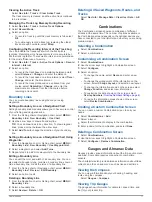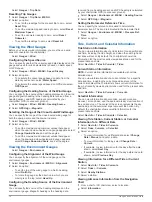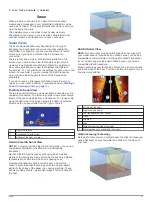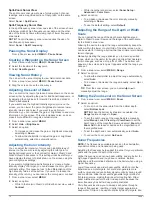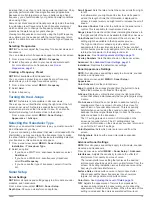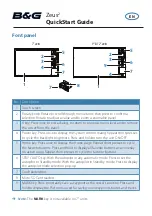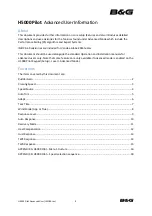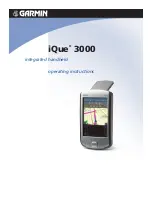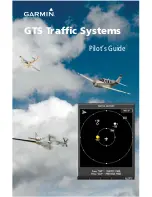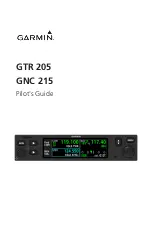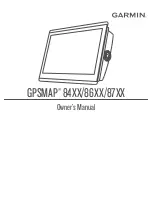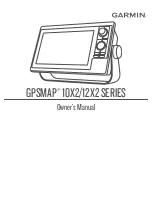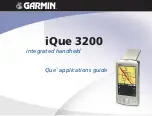
to a target. The radar system automatically tracks the tagged
object and provides you with information about the object,
including the range, bearing, speed, GPS heading, nearest
approach, and time to nearest approach. MARPA indicates the
status of each tagged object (acquiring, lost, tracking, or
dangerous), and the chartplotter can sound a collision alarm if
the object enters your safe zone.
MARPA Targeting Symbols
Acquiring a target. Concentric, dashed green rings radiate from
the target while the radar is locking onto it.
Target has been acquired. A solid green ring indicates the
location of a target that the radar has locked onto. A dashed
green line attached to the circle indicates the projected course
over ground or the GPS heading of the target.
Dangerous target is in range. A red ring flashes from the target
while an alarm sounds and a message banner appears. After
the alarm has been acknowledged, a solid red dot with a dashed
red line attached to it indicates the location and the projected
course over ground or the GPS heading of the target. If the safe-
zone collision alarm has been set to Off, the target flashes, but
the audible alarm does not sound and the alarm banner does
not appear.
Target has been lost. A solid green ring with an X through it
indicates that the radar could not lock onto the target.
Closest point of approach and time to closest point of approach
to a dangerous target.
Assigning a MARPA Tag to an Object
Before you can use MARPA, you must have a heading sensor
connected and an active GPS signal. The heading sensor must
provide the NMEA 2000 parameter group number (PGN)
127250 or the NMEA 0183 HDM or HDG output sentence.
1
From the Harbor, Offshore, or Cruising Radar screen, select
an object or location.
2
Select
Acquire Target
>
MARPA Target
.
Viewing Information about a MARPA-tagged Object
You can view the range, bearing, speed, and other information
about a MARPA-tagged object.
1
From a radar screen, select a targeted object.
2
Select
MARPA Target
.
Removing a MARPA Tag from a Targeted Object
1
From the Radar screen, select a MARPA target.
2
Select
MARPA Target
>
Remove
.
Showing AIS Vessels on a Chart or 3D Chart View
Before you can use AIS, you must connect the chartplotter to an
external AIS device and receive active transponder signals from
other vessels.
You can configure how other vessels appear on a chart or on a
3D chart view. The display range configured for one chart or one
3D chart view are applied only to that chart or to that 3D chart
view. The details, projected heading, and trails settings
configured for one chart or one 3D chart view are applied to all
charts and to all 3D chart views.
1
From a chart or 3D chart view, select
MENU
>
Other
Vessels
>
AIS/MARPA Dis. Setup
.
2
Select an option:
• To indicate the distance from your location in which AIS
vessels appear, select
Display Range
, and select a
distance.
• To show details about AIS-activated vessels, select
Details
>
Show
.
• To set the projected heading time for AIS-activated
vessels, select
Proj. Heading
, and enter the time.
• To show the tracks of AIS vessels, select
Trails
, and
select the length of the track that appears using a trail.
Showing AIS Vessels on the Radar Screen
AIS requires the use of an external AIS device and active
transponder signals from other vessels.
You can configure how other vessels appear on the Radar
screen. If any setting (except the AIS display range) is
configured for one radar mode, the setting is applied to every
other radar mode. The details and projected heading settings
configured for one radar mode are applied to every other radar
mode and to the Radar overlay.
1
From a Radar screen or the Radar overlay, select
MENU
>
Other Vessels
>
AIS/MARPA Dis. Setup
.
2
Select an option:
• To indicate the distance from your location within which
AIS vessels appear, select
AIS Dis. Range
, and select a
distance.
• To show details about AIS-activated vessels, select
Details
>
Show
.
• To set the projected heading time for AIS-activated
vessels, select
Projected Heading
, and enter the time.
• To show the tracks of AIS vessels, select
Trails
, and
select the length of the track that appears.
Viewing a List of AIS Threats
From any Radar screen or the Radar overlay, you can view and
customize the appearance of a list of AIS threats.
From a Radar screen or the Radar overlay, select
MENU
>
Other Vessels
>
AIS/MARPA List
.
VRM and EBL
The variable range marker (VRM) and the electronic bearing line
(EBL) measure the distance and bearing from your boat to a
target object. On the Radar screen, the VRM appears as a circle
that is centered on the present location of your boat, and the
EBL appears as a line that begins at the present location of your
boat and intersects the VRM. The point of intersection is the
target of the VRM and the EBL.
Showing the VRM and the EBL
The VRM and the EBL configured for one mode are applied to
other radar modes.
NOTE:
The VRM and the EBL cannot be changed in sentry
mode.
From a Radar screen, select
MENU
>
Show VRM/EBL
.
Adjusting the VRM and the EBL
Before you can adjust the VRM and the EBL, you must show
them on the Radar screen (
).
You can adjust the diameter of the VRM and the angle of the
EBL, which moves the intersection point of the VRM and the
EBL. The VRM and the EBL configured for one mode are
applied to all other radar modes.
1
From a Radar screen, select
MENU
>
Adjust VRM/EBL
>
Move VRM/EBL
.
2
Use the arrow keys to adjust the VRM and EBL.
3
Select
Done
.
Measuring the Range and Bearing to a Target Object
Before you can adjust the VRM and the EBL, you must show
them on the Radar screen (
).
1
From a Radar screen, select the target location.
2
Select
Measure Distance
.
The range and the bearing to the target location appear in the
upper-left corner of the screen.
Radar
19
Summary of Contents for AQUAMAP 80 Series
Page 1: ...AQUAMAP 80 100 Series Owner s Manual November 2016 Printed in Taiwan 190 01657 00_0C...
Page 6: ......
Page 35: ......







